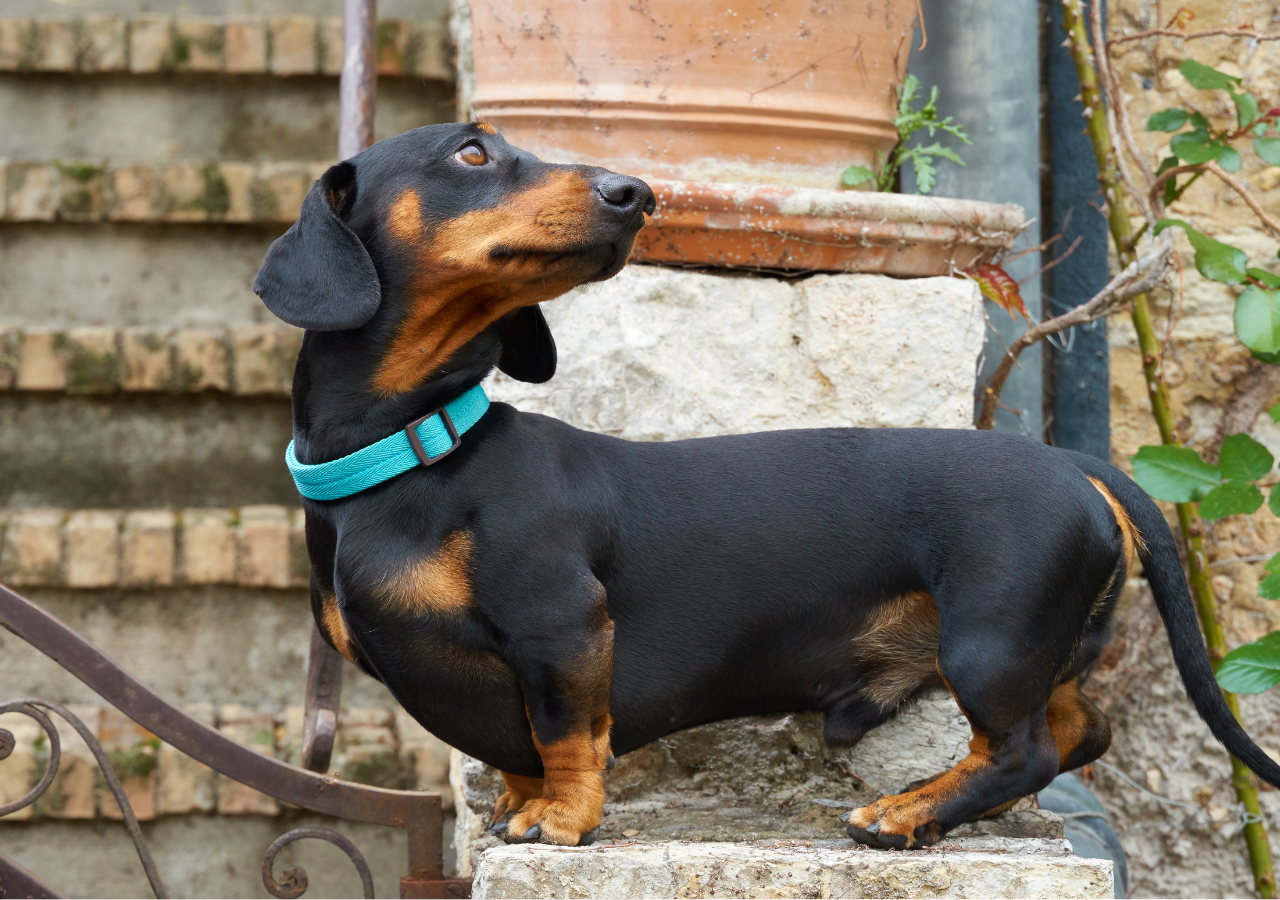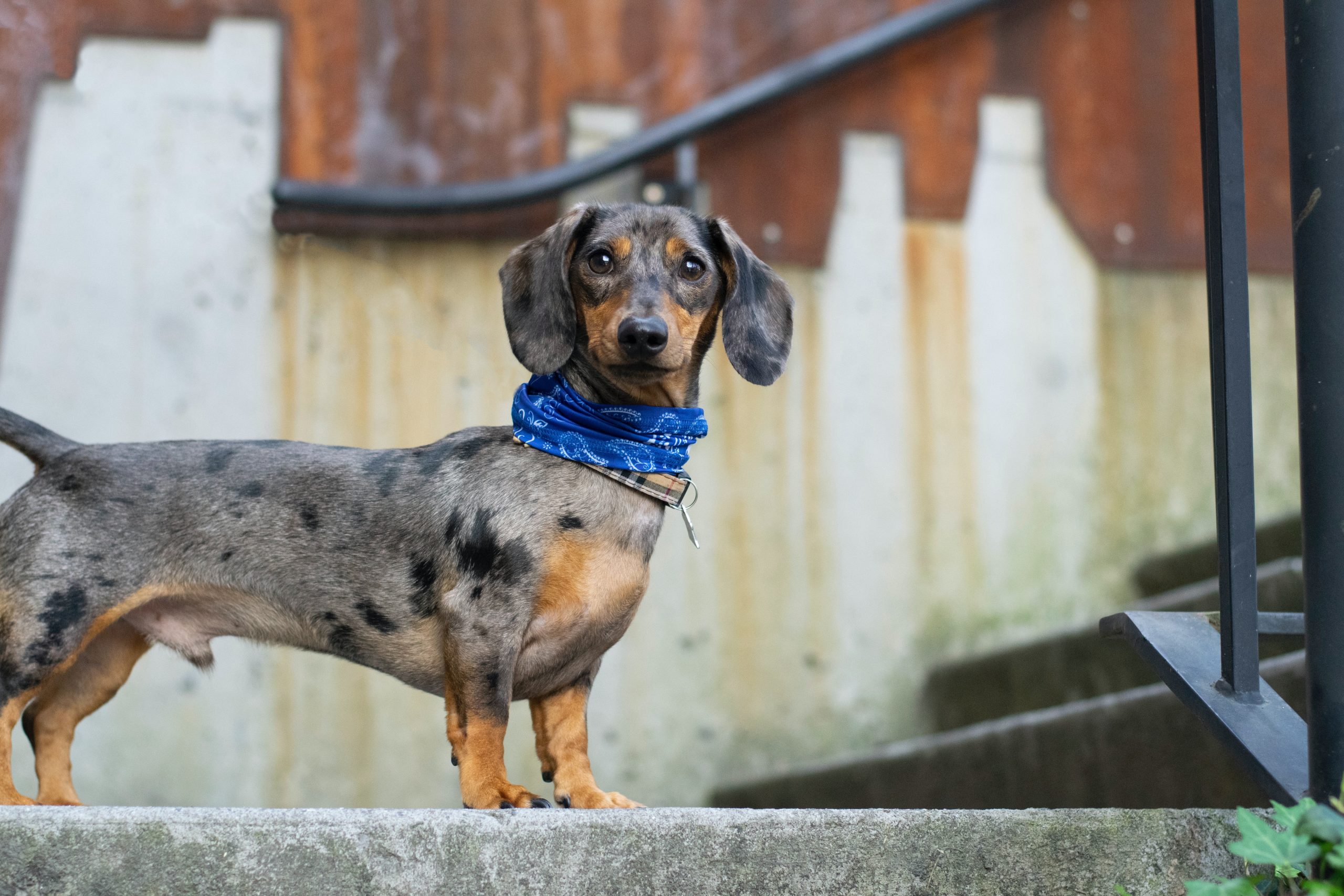Hip dysplasia in dogs, particularly in breeds like Dachshunds, is a condition that can significantly impact their quality of life. To fully understand this condition, it’s essential to explore its anatomical aspects and how it specifically affects these Wiener dogs. If spotted on time, Dachshund hip dysplasia can be successfully treated and your dog can live a normal life.
The Anatomy of Dachshund Hip Dysplasia
Hip dysplasia is a developmental disorder of the hip joints, where the ball and socket joint does not fit or develop properly. In a healthy dog, the hip joint functions as a ball and socket, allowing for smooth, pain-free movement. However, in a dog with hip dysplasia, this fit is imperfect. This misalignment can be due to a variety of factors, including genetics, lifestyle, and environmental influences.
In Dachshunds, the condition is exacerbated due to their unique body structure. Being a breed with a long spine and short legs, they are already predisposed to various skeletal issues. When hip dysplasia is present, it can lead to an uneven distribution of weight and stress on their hip joints, exacerbating the condition.

How Hip Dysplasia Affects Dachshunds
For Dachshunds, hip dysplasia can manifest in several ways. Initially, it may present as a subtle change in their gait or a slight reluctance to jump or climb stairs. As the condition progresses, the symptoms become more pronounced. These can include visible discomfort during movement, difficulty in rising from a resting position, and an apparent decrease in activity levels.
The structural changes in the hip joint due to dysplasia lead to a gradual deterioration of the joint, causing pain and inflammation. Over time, this can result in a loss of cartilage, the development of scar tissue, and the formation of bone spurs around the joint. All these changes contribute to the painful symptoms associated with hip dysplasia.
Impact on Mobility and Quality of Life
The mobility of a Dachshund with hip dysplasia is significantly affected. Activities that were once easy and enjoyable become challenging and painful. This limitation in movement not only affects their physical health but can also lead to psychological effects such as depression or anxiety due to decreased activity and interaction.
Furthermore, hip dysplasia can lead to a vicious cycle of pain and inactivity. The less the dog moves, the weaker their muscles become, further straining the already compromised hip joints. This cycle can be detrimental to their overall health and quality of life.

How To Recognize The Symptoms of Hip Dysplasia in Dachshunds?
Recognizing signs of hip dysplasia in Dachshunds early is crucial for effective management and treatment. As a Dachshund owner, being aware of these symptoms can help you detect this condition in your dog. Below are the most common signs of hip dysplasia in Dachshunds, each explained with short descriptions to help you better understand and identify them:
Lameness or Limping:
One of the first and most noticeable signs of hip dysplasia in Dachshunds is a change in their walk. You might observe:
- An uneven gait or a limp, especially after they wake up or following periods of rest.
- Difficulty in getting up or reluctance to stand on their hind legs.
Reduced Activity Levels:
Dachshunds are generally active and playful. However, with hip dysplasia, they might:
- Show less enthusiasm for activities they previously enjoyed, like running or playing.
- Prefer lying down or resting over moving around.
Difficulty with Movements:
Due to the discomfort in their hips, affected Dachshunds often struggle with certain movements:
- Difficulty climbing stairs or jumping onto furniture, which they could do effortlessly before.
- Hesitance or inability to perform actions that require hip movement, like squatting to defecate.
Painful Reactions to Touch:
Hip dysplasia can make the hip area sensitive to touch, so you might notice:
- Signs of pain or discomfort when you touch their hips or lower back.
- A tendency to nip or growl if their hip area is handled.
Altered Sitting Position:
Dachshunds with hip dysplasia might change the way they sit:
- Sitting with a leg splayed sideways rather than neatly tucked under.
- Avoiding sitting positions that put pressure on their hips.
Muscle Loss in Hind Legs:
Over time, due to reduced activity and use, muscle wastage can occur:
- Noticeable thinning or weakening of the muscles in the hind legs.
- An imbalance in muscle tone between the front and back of the body.
Changes in Behavior:
Pain and discomfort can lead to changes in their usual behavior:
- Increased irritability or mood swings, especially if they’re in pain.
- Loss of interest in interacting with family members or other pets.
Audible Sounds from Hip Joints:
In severe cases, you might hear:
- Popping or cracking sounds from their hip joints during movement.
- These sounds are indicative of joint problems and should be a prompt for veterinary consultation.

What Are The Possible Treatments for Dachshund Hip Dysplasia?
Hip dysplasia in Dachshunds, a condition that can significantly impact their mobility and quality of life, requires a well-thought-out treatment plan. Treatments for this condition can be broadly categorized into non-surgical and surgical options. Each treatment has its specific purposes and outcomes, tailored to the severity of the condition and the individual needs of the dog. Below is a comprehensive list of these treatments, along with brief explanations for each:
Non-Surgical Treatments
Weight Management:
- Keeping the dog at a healthy weight reduces stress on the hips. Overweight dogs experience more pain and deterioration in the hip joints.
Physiotherapy and Exercise:
- Regular, gentle exercises help maintain joint mobility and muscle strength. Avoid high-impact activities that can exacerbate the condition.
Pain Relief Medications:
- Nonsteroidal anti-inflammatory drugs (NSAIDs) are commonly used to manage pain and inflammation. Always administer under veterinary guidance.
Joint Supplements:
- Supplements like glucosamine and chondroitin support joint health and can slow the progression of hip dysplasia. Omega-3 fatty acids also have anti-inflammatory properties.
Physical Therapy:
- Techniques such as massage and hydrotherapy can improve joint mobility and reduce discomfort.
Acupuncture:
- An alternative therapy that can help manage pain and improve mobility in some dogs.
Orthopedic Beds:
- Specially designed Dachshund beds provide support for the dog’s joints, making resting and sleeping more comfortable.
Assistive Devices:
- Harnesses and wheelchairs can help dogs with severe hip dysplasia move around more easily and maintain an active lifestyle.
Surgical Treatments
Triple Pelvic Osteotomy (TPO):
Ideal for pups without any joint issues. So, the surgery is all about making incisions on the pelvic bones so that the hip joint can be positioned correctly.
Femoral Head Ostectomy (FHO):
It means removing the head and neck part of the thigh bone. This is a cheaper alternative that also works well for smaller dogs, such as Dachshunds.
Total Hip Replacement (THR):
Many vets share the same opinion that the most effective surgical option for severe hip dysplasia would be a total hip replacement. This procedure involves replacing the whole hip joint with artificial materials.
Juvenile Pubic Symphysiodesis:
An operation that hand brawned young pooches. It improves hip joint alignment by altering the growth of the pelvis.
Arthroscopy:
Used to identify certain hip conditions in which a part of the sitting bones moves outside the hip socket leading to pain and discomfort. Arthroscopy involves examining the hip joint by means of small incisions and the use of tools and a camera.
Each of these treatments has its benefits and limitations. The choice of treatment should be based on a thorough veterinary evaluation, considering factors such as the dog’s age, overall health, severity of the dysplasia, and lifestyle. The goal of any treatment plan is to improve the quality of life for the dog, reducing pain, and maintaining mobility for as long as possible. Regular follow-ups and adjustments in the treatment plan may be necessary as the condition progresses or as the dog ages.
READ ALSO: DACHSHUND TEETH: HOW TO KEEP THEM HEALTHY & STRONG?
How Can Sleeping on The Right Bed Help Your Dachshund with Hip Dysplasia?
While proper medical care and exercise play essential roles in managing this condition, many pet owners overlook the importance of choosing the right bed for their furry friends. In this blog post, we’ll explore how selecting the appropriate bed can significantly impact a Dachshund’s comfort and overall hip health.
Supportive Orthopedic Beds:
Investing in an orthopedic bed is one of the most effective ways to help a Dachshund with hip dysplasia. These beds are specifically designed to provide superior support to your dog’s joints and spine. Look for memory foam or high-density foam options that conform to your Dachshund’s body, distributing weight evenly and reducing pressure on the hips.
Size Matters:
Ensure that the bed is appropriately sized for your Dachshund. A bed that is too small can force your dog into uncomfortable positions, exacerbating hip issues. Ideally, the bed should be large enough for your Dachshund to stretch out comfortably while still being snug.
Easy Access:
Dachshunds with hip dysplasia may struggle to jump onto high beds. Opt for a bed that has a lower profile, making it easier for your dog to climb on and off without straining their hips. This can prevent unnecessary stress on their joints.
Washable and Durable Materials:
Choose a bed with removable and machine-washable covers. Hip dysplasia often leads to accidents, and having a bed that’s easy to clean is essential. Additionally, look for durable materials that can withstand your Dachshund’s scratching and nesting behaviors.
Temperature Control:
Maintaining a comfortable temperature is crucial for dogs with hip dysplasia. Beds with cooling or heating elements can help regulate your Dachshund’s body temperature, reducing inflammation and discomfort in the hips.
READ ALSO: Separation Anxiety in Dachshunds: The Best Treatment Tips & Tricks



Pingback: Top 7 Facts To Know About Dachshund and French Bulldog Mix | Dachshund Space
Pingback: Why Do Dachshunds Sleep So Much? 5 Important Things to Know
Pingback: Dachshund Jumping: 3 Best Tips & Important Facts for Owners
Pingback: What Is the Rarest Dachshund Color? 4 Facts To Keep In Mind